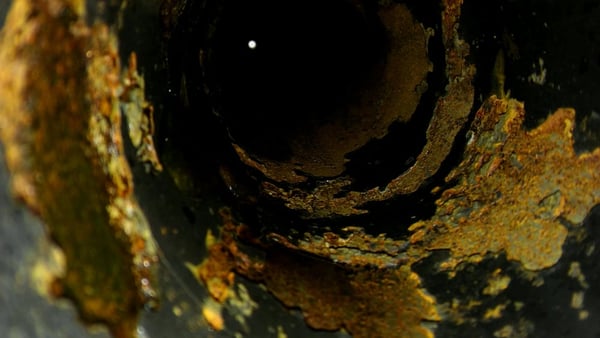Share this
Overlooking Dead Leg Piping Corrosion Can Have Significant Consequences for California Refineries
by Morgan Zealear on 5/13/21 9:00 AM

Dead legs are sections of piping systems that rarely see flow but are still exposed to the process. This is applicable for any piping that may contain idle, stagnant, or intermittent flow. Dead legs occur in just about any piping system and are historically problematic, as eliminating dead legs from a design may not always be possible. While the effects of dead legs can typically be mitigated, the consequences can multiply when corrosion is present in the piping.
Dead leg piping corrosion in grab sampling systems poses serious issues for refineries, especially when dealing with heavier, more viscous samples in the Bay Area. Obtaining samples of crude oil is an extremely important part of everyday processes in refineries. Grab sampling systems contain many dead legs, such as in instrument connections, sample valves, stagnant control valve bypass piping, relief valves, and transducers. With the abundance of dead legs that may be subject to corrosion, it is crucial for process engineers to understand the consequences and how to mitigate and resolve the effects.
Consequences of Dead Leg Piping Corrosion
The rate and severity of dead leg piping corrosion is dependent on the fluid, leg orientation, pipe wall thickness, and piping configuration. Dead legs in grab sampling systems in refineries are particularly susceptible to corrosion due to the corrosive components that may be found in addition to hydrocarbons in crude oil; these may include chlorides, carbon dioxide, organic acids, sulfur, and even bacteria. Dead leg piping corrosion coupled with the typical effects of dead legs may often result in a non-representative sample to be taken and may pose a threat to equipment and piping integrity.
Lack of Representative Samples
Dead legs alone may prevent operators from obtaining a representative sample, inhibiting refineries’ ability to manage quality control. If the piping is not thoroughly purged, remnants of old samples are stored in the dead leg region and the new samples may become contaminated as they flow through the line. Highly viscous crude oil can even block the dead leg region in some cases.
When corrosion, whether pitted or crevice, is present in a dead leg, this makes purging the pipe even more challenging. The old samples will get stuck in these pits or crevices and will continue to contaminate the new samples, while also leading to further corrosion in these vulnerable areas. If operators are unable to obtain a representative sample, process engineers are unable to draw conclusions on process efficacy and make informed decisions.
Compromised Piping Integrity
Perhaps the most critical threat posed by dead leg piping corrosion is overall safety of the sampling system. If corrosion in the piping interior goes unnoticed and gets to a critical stage, the fluid can escape from the dead leg, posing a safety hazard; this not only poses safety risk to refinery personnel, but also to the surrounding environment, which may result in an OSHA violation. Corrosion of dead legs is a slow process, so oftentimes addressing the issue may be placed on the back burner. However, if this issue is put off long enough, the corrosion may lead to catastrophic system failure leading to even longer unplanned downtime for refineries.
Mitigation the Effects of Dead Leg Piping Corrosion
Once dead leg corrosion has been identified to be problematic, there are a number of measures that can be taken to mitigate these effects:
|
Prioritize |
Inspect dead legs and identify which dead legs are most problematic to appropriately determine risk and prioritize where modifications or improvements need to be made. |
|
Minimize Dead Legs |
Choose a configuration that inherently reduces the number of dead legs to reduce risk and increase overall sampling reliability. |
|
Minimize Dead Leg Volume |
Verify that all critical dead leg components upstream of the sampling container have proper high-quality connections. |
|
Stop Corrosion Early |
Implement piping materials that are less susceptible to corrosion and minimize the number of crevices in the design that could be subject to corrosion. |
|
Increase Flow Rate |
Increasing the flow rate can reduce the risk of sample contamination. |
|
Thoroughly Purge |
While thorough purging does take up operator time, it can ensure the old samples have been successfully flushed out of the system. |
While these tips can help mitigate the effects, consulting with local experts who are well-versed in designing around these challenges is the best method for success.
The Value of Local Expertise
If you are looking to reduce the effects of dead leg piping corrosion in grab sampling systems or elsewhere in refineries, look to local experts that understand your specific needs. Swagelok Northern California has over five decades of experience working with oil and gas companies across the California Bay Area and brings invaluable local experience to the table. Our local field engineers are readily available to work with you to identify prospective problems and guide you to the ideal solution for your process requirements.
To find out more about how Swagelok Northern California can help you reduce the effects of dead leg piping corrosion by providing expert consultation with Swagelok's Field Engineers, contact our team today by calling 510-933-6200.
 Morgan Zealear | Product Engineer – Assembly Services
Morgan Zealear | Product Engineer – Assembly Services
Morgan holds a B.S. in Mechanical Engineering from the University of California at Santa Barbara. He is certified in Section IX, Grab Sample Panel Configuration, and Mechanical Efficiency Program Specification (API 682). He is also well-versed in B31.3 Process Piping Code. Before joining Swagelok Northern California, he was a Manufacturing Engineer at Sierra Instruments, primarily focused on capillary thermal meters for the semiconductor industry (ASML).
Share this
- Archive (465)
- Assembly Services (207)
- About (100)
- Seal Support Systems (96)
- Best Practices (88)
- Training Services (74)
- Fittings (51)
- Semiconductor Applications (49)
- Hoses and Flexible Tubing (47)
- Regulators (44)
- Tubing (42)
- Grab Sampling Systems (32)
- Sampling Systems (32)
- Gas Systems (30)
- Services (30)
- Downloads (29)
- Valves (24)
- Application Support (18)
- Orbital Welding (17)
- Case Studies (13)
- Steam Systems (13)
- Frequently Asked Questions (12)
- Tools (12)
- Measurement Devices (7)
- Subsystems (6)
- Thermal Management (6)
- September 2023 (1)
- August 2023 (2)
- June 2023 (1)
- March 2023 (3)
- February 2023 (3)
- January 2023 (4)
- December 2022 (4)
- November 2022 (4)
- October 2022 (4)
- September 2022 (1)
- August 2022 (3)
- July 2022 (2)
- June 2022 (4)
- May 2022 (1)
- April 2022 (2)
- March 2022 (1)
- February 2022 (2)
- January 2022 (3)
- December 2021 (1)
- November 2021 (6)
- October 2021 (6)
- September 2021 (8)
- August 2021 (4)
- July 2021 (3)
- June 2021 (6)
- May 2021 (6)
- April 2021 (7)
- March 2021 (5)
- February 2021 (4)
- January 2021 (6)
- December 2020 (5)
- November 2020 (6)
- October 2020 (6)
- September 2020 (8)
- August 2020 (7)
- July 2020 (8)
- June 2020 (8)
- May 2020 (6)
- April 2020 (9)
- March 2020 (7)
- February 2020 (10)
- January 2020 (21)
- December 2019 (23)
- November 2019 (21)
- October 2019 (22)
- September 2019 (21)
- August 2019 (22)
- July 2019 (23)
- June 2019 (20)
- May 2019 (23)
- April 2019 (22)
- March 2019 (21)
- February 2019 (20)
- January 2019 (21)
- December 2018 (14)
- November 2018 (19)
- October 2018 (23)
- September 2018 (17)
- August 2018 (29)
- July 2018 (11)
- June 2018 (6)
- May 2018 (5)
- April 2018 (4)
- March 2018 (5)
- February 2018 (3)
- January 2018 (3)
- December 2017 (2)
- November 2017 (4)
- October 2017 (3)
- September 2017 (2)
- August 2017 (6)
- July 2017 (4)
- June 2017 (4)
- May 2017 (4)
- April 2017 (3)
- March 2017 (4)
- February 2017 (3)
- January 2017 (3)
- December 2016 (3)
- November 2016 (3)
- October 2016 (3)
- September 2016 (5)
- August 2016 (5)
- July 2016 (4)
- June 2016 (5)
- May 2016 (3)
- April 2016 (4)
- March 2016 (5)
- February 2016 (11)
- January 2016 (1)
- December 2015 (3)
- November 2015 (4)
- October 2015 (3)
- September 2015 (4)
- August 2015 (4)
- July 2015 (8)
- June 2015 (5)
- May 2015 (3)
- April 2015 (4)
- March 2015 (4)
- February 2015 (3)
- January 2015 (4)
- December 2014 (2)
- November 2014 (3)
- October 2014 (4)
- September 2014 (4)
- August 2014 (4)
- July 2014 (5)
- June 2014 (4)
- May 2014 (4)
- April 2014 (5)
- March 2014 (4)
- February 2014 (3)
- January 2014 (4)
- December 2013 (5)
- November 2013 (3)
- October 2013 (4)
- September 2013 (3)
- August 2013 (5)
- July 2013 (5)
- June 2013 (5)
- May 2013 (3)
- April 2013 (6)
- March 2013 (4)
- February 2013 (4)
- January 2013 (8)
- December 2012 (4)
- November 2012 (6)
- October 2012 (6)
- September 2012 (4)
- August 2012 (4)
- July 2012 (4)
- June 2012 (4)

.webp?width=210&height=70&name=StickyLogo%20(5).webp)